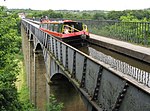Stanlow Island
Cheshire geography stubsEllesmere PortIslands of EnglandRiver MerseyUninhabited islands of England ... and 1 more
Wikipedia external links cleanup from January 2024

Stanlow Island is a small island found on the Manchester Ship Canal outside the Stanlow Oil Refinery. The island was occupied until the 1990s when the locals left due to isolation and the hazards of living nearby the refinery. Notable structures are the remains of Stanlow Abbey founded in 1178 that still remain at Stanlow Point. Access to the island using a 24-hour request ferry that links the Essar refinery to Stanlow Island with special permission.
Excerpt from the Wikipedia article Stanlow Island (License: CC BY-SA 3.0, Authors, Images).Stanlow Island
Corridor Road,
Geographical coordinates (GPS) Address Nearby Places Show on map
Geographical coordinates (GPS)
| Latitude | Longitude |
|---|---|
| N 53.289722222222 ° | E -2.8611111111111 ° |
Address
Stanlaw Abbey
Corridor Road
CH65 4EQ , Ellesmere Port
England, United Kingdom
Open on Google Maps








